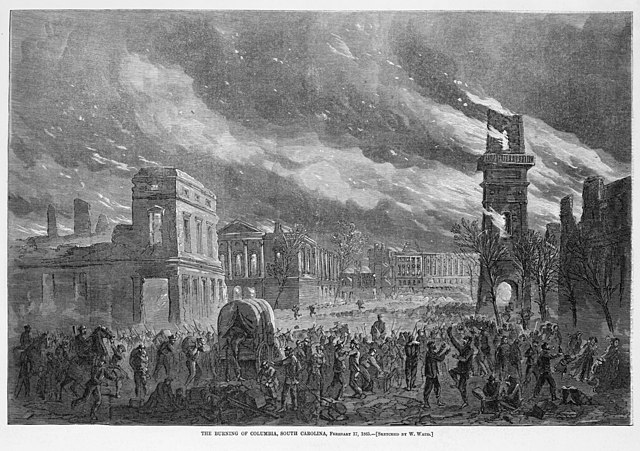Loading AI tools
Patrick Neeson Lynch
Catholic bishop From Wikipedia, the free encyclopedia
Patrick Neeson Lynch (March 10, 1817 – February 26, 1882) was an Irish-born prelate of the Roman Catholic Church. He served as bishop of the Diocese of Charleston in the Southeastern United States from 1857 until his death in 1882.
The Most Reverend Patrick Neeson Lynch | |
|---|---|
| Bishop of Charleston | |
 | |
| Church | Roman Catholic Church |
| See | Diocese of Charleston |
| In office | December 11, 1857— February 26, 1882 |
| Predecessor | Ignatius A. Reynolds |
| Successor | Henry P. Northrop |
| Orders | |
| Ordination | April 5, 1840 |
| Consecration | March 14, 1858 |
| Personal details | |
| Born | March 10, 1817 Kibberidogue, County Fermanagh, Ireland |
| Died | February 26, 1882 (aged 64) Charleston, South Carolina, United States |
| Education | Seminary of St. John the Baptist Pontifical Urban College |
| Signature | |
Patrick Lynch's birthplace is sometimes attributed to Clones, County Monaghan but he was actually born in the County Fermanagh portion of the Parish of Clones, probably in the townland of Kibberidogue. His parents were Conlaw Peter and Eleanor (née Neison) Lynch. Eleanor's father disapproved of the marriage and disinherited her. Lynch was a granduncle of US Navy Admiral Patrick N. L. Bellinger.
In 1819, the Lynch family immigrated to the United States, settling in Cheraw, South Carolina. Like their neighbors, they became slave owners.[1] Lynch was one of fourteen children, twelve of whom lived to maturity. One sister became a Carmelite nun in Baltimore, another sister became an Ursuline nun; his brother John became a doctor in Columbia, South Carolina.
Lynch studied at the diocesan Seminary of St. John the Baptist, then entered the Pontifical Urban College in Rome, where he graduated with a Doctor of Divinity degree.[2]
Lynch was ordained to the priesthood in Rome for the Diocese of Charleston on April 5, 1840 by Cardinal Giacomo Filippo Fransoni.[3] After his ordination, Lynch was assigned to the pastoral staff of the Cathedral of Saint John and Saint Finbar in Charleston. He served for a time editor of the United States Catholic Miscellany, founded by Bishop John England. Bishop Reynolds appointed Lynch pastor of St. Mary's Parish in Charleston and as vicar-general of the diocese.[2]
After the death of Reynolds in 1855, Lynch was elected as apostolic administrator of Charleston. On December 11, 1857, he was appointed bishop of Charleston by Pope Pius IX. Lynch was consecrated on March 14, 1858, at the Cathedral of Saint John and Saint Finbar by Archbishop Francis Kenrick.[3]
Lynch was the third bishop of Charleston, which at the time covered North Carolina, South Carolina, Georgia, the Bahamas and Bermuda. The diocese was later reduced to the state of South Carolina.

In the first year of the American Civil War, a major fire in December 1861 destroyed the cathedral, the bishop's residence and the diocesan library. The bombardment of Charleston by the Union Army for nearly two years closed most of the churches and impoverished the congregations.[2]
On February 20, 1864, Lynch was named by President Jefferson Davis of the Confederate States of America (CSA) as its delegate to the Vatican. Lynch then travelled to Rome. Since the Vatican had never recognized the CSA, Lynch did not present his diplomatic credentials to Pius IX, who received him only in as a bishop.[4][5]
Like his predecessors, Pius had condemned slavery. During Lynch's audience, Pius suggested that "something might be done looking to an improvement in [the slaves'] position or state, and to a gradual preparation for their freedom at a future opportune time."[6]

During the 1865 burning of Columbia, South Carolina, St. Mary's College, the Sisters' Home, and the Ursuline Convent were all destroyed. After the end of the war, US President Andrew Johnson pardoned Lynch for his role as Vatican delegate for the Confederacy.[2]
With a diocesan debt exceeding $200,000, Lynch began soliciting donations throughout the country to keep the diocese functioning and to pay off the debt. Lynch attended the First Vatican Council in Rome from 1869 to 1870.[2]
Lynch died in Charleston on February 26, 1882, at age 64.[3]
Seamless Wikipedia browsing. On steroids.
Every time you click a link to Wikipedia, Wiktionary or Wikiquote in your browser's search results, it will show the modern Wikiwand interface.
Wikiwand extension is a five stars, simple, with minimum permission required to keep your browsing private, safe and transparent.